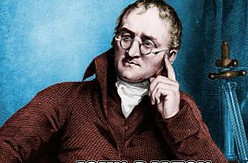Part 2 - What's the Matter
March 2019


From an early age I have always been fascinated by matter. This stuff that is all around us. The stuff that we can touch and feel and is what we are made of. But I always wondered what is matter made of and where did it all come from?
I am not alone in this. I found that people had been thinking of this for a long time.
The atomic philosophy of the early Greeks
In the 5th century BCE, an ancient Greek called Democritus named the building blocks of matter atomos, meaning literally “indivisible,” so you see where we get atoms from. Democritus believed that atoms were uniform, solid, hard, incompressible, and indestructible and that they moved in infinite numbers through empty space until stopped. Differences in atomic shape and size determined the various properties of matter. In Democritus’s philosophy, atoms existed not only for matter but also for such qualities as perception and the human soul.
Fast forward 2000 years and you come to John Dalton. Dalton was born in 1766 and died in 1844. He was an English chemist, physicist, and meteorologist. He is best known for introducing the atomic theory into chemistry.
Dalton published his ideas about atoms in 1803. He thought that all matter was made of tiny particles called atoms, which he imagined as tiny solid balls. Dalton's model included these ideas:
-
atoms cannot be broken down into anything simpler
-
the atoms of a given element are identical to each other
-
the atoms of different elements are different from one another
-
during chemical reactions atoms rearrange to make different substances
At school I was taught that atoms are composed of electrons (discovered in 1897), protons (discovered in 1918), and neutrons (discovered in 1932). Atoms of an element have identical numbers of protons and electrons, but can have different numbers of neutrons and atoms of different elements have different numbers of protons and electrons.
But if you think about the atoms in your particular body, then your body has been around for many years – but not necessarily in the same shape or format.
There was a study done by Paul Aebersold in 1953 at the Oak Ridge Laboratory in America. He found that 98 percent of all the atoms in a person’s body change out every year, and that within five years all the atoms had changed.
So, every month you get a new suit of skin and every six weeks a new liver.
The lining of your stomach lasts only five days before it’s replaced.
Even your bones are not the solid, stable, concrete-like things you might have thought them to be: They are undergoing constant change. The bones you have today are different from the bones you had a year ago.
Experts in this area of research have concluded that there is a complete, 100 percent turnover of atoms in the body at least every five years.
In other words, not one single atom present in your body today was there five years ago.
Well, I would agree except for scars – my finger has a scar on it from when I was 5 and it’s still with me.
But when you think of it, your nails grow and are cut off and regrow. Ditto for your hair. You cut yourself and your skin heals and flakes off. And goes ... To form dust in your house, of course?!? Exactly.
A mate of mine said he never vacuumed the house because after the first 6 months the dust doesn’t get any deeper. But is it all made of human skin?
No, this is one of those gross factoids that sound very scientific, but isn’t really true. Sometimes a specific percentage of dust is said to be skin, usually about 70 or 80 percent, but unless you’re a moulting bird or a reptile (or you work in Dr. Frankenstein’s laboratory), very little of your environment is composed of dead body tissue.
There are far more common sources of dust pollutants, including animal dander (like dandruff), sand, insect waste, flour (in the kitchen), and of course lots of good, old-fashioned dirt.
Every time we open a window or a door, we stir up and move around tiny, airborne particles that eventually settle around the house. Humans do shed dead skin, but most of it is carried away by water when we shave or bathe, ending up not on our floors but in our sewers. Now don’t you feel a bit better?
But let’s return to the atoms in our bodies, I was born in 1959 and this body is the result of me eating and drinking for all those years. However, if you go back to 1958 then I didn’t exist. The atoms that currently make up this body existed, but I didn’t exist in a body.
And if you go back 90 years then my parents didn’t exist.
If you go back 200,000 years, then no human beings existed.
If you go back 6 million years, then the ancestors of human beings didn’t exist.
If you go back 4 billion years ago then no life existed on earth.
If you go back 5 billion years, then the sun and the earth didn’t exist.
And if you back far enough to 13.8 billion years then the universe is not supposed to have existed.
The current thinking is that the Universe started with the Big Bang which brought all matter into existence.
But other explanations have been put forward besides the Big Bang and I will explore these in the next part – Part 3 Creation Myths
